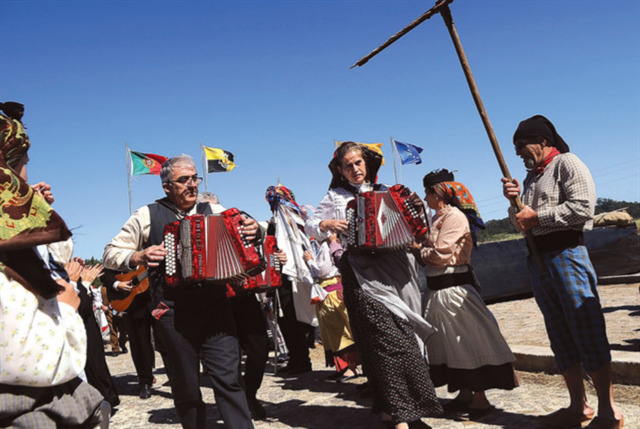|

A place known in Vagos for being an old pier where the “moliço” (seagrass) was transacted, a precious asset of those times!
Every year there is the “Moliço Festival”, a festival that seeks to make this art known to younger generations. The Foclore Rancho of Santo António de Vagos joins this party with its regional songs and dances. Always preoccupied with recovering from the past the best memories and keeping alive some of the traditions that help define the soul of the people, the group associates its festival with the tradition of gathering and selling the “moliço” by the river, animating this camp.
According to Mr. Matos Sousa, "the moliço was discharged here and taken up by oxen joints. And who had no animals brought the moliço to his head, to till the land. Those were difficult times! "
Foto: Ricardo Carvalhal

Events of this nature serve this purpose: to revive. And this is what happens, at this point, with the Moliceiros boats starting from the north of the town of Vagos and crossing the river to Folsas Novas. A trip of about one hour, taking a different color to the Boco River, which is one of the places of reference for birdwatching and, for that fact, referenced in the Birdwatching Roadmap of the Ria de Aveiro. There are those who go to the banks to watch this "old movie", but many others focus on the Folsas Novas, an area where the autarky has hosted this type of event with the quality it deserves.

The moliço is a vegetal association, constituted by vascular plants and algae, that grows submerge in the bed of the river and for centuries was caught for agricultural use in the enrichment of the cultivated lands.
Moliço is the name given to aquatic plants that are harvested for use in agriculture. This word comes from the Latin mollis, which expresses the mole quality. The designation of moliço is generally used for vascular plants that grow submerged in salt water, which in English are called seagrass, but can also be applied to the algae that grow in the middle of these plants. A different case is that of other algae, including seaweed of the genus Sargassus, called sargassus, which were harvested in the surfing zone of the northern beaches of Portugal, also for use in agriculture.
look @:
https://www.youtube.com/watch?v=nkCz9_eGJrk
Moliço was particularly important in the coastal lagoon of Ria de Aveiro, located on the northern coast of Portugal. Here the grain was harvested in large quantities by rakes drawn from a moliceiro boat. The most abundant plants in the moliço belonged to the genus Zostera, especially Z. noltii (cirgo), but also included other salt water tolerant aquatic plants, such as Ruppia and Potamogeton.
In the 19th and 20th centuries, the harvesting of sugarcane had an important role in removing plant nutrients from the Ria de Aveiro, helping to stabilize this eutrophic lagoon and that for centuries was harvested for agricultural use in the enrichment and conditioning of sandy soils, one of the most important facts in the transformation of these lands into arable land.
This area has considerable biodiversity. The gray hairs serpents of small canals provide areas for feeding, sheltering and breeding of various species of birds. The Red Heron (Ardea purpurea), the Eagle-sapeira (Circus aeruginosus), the Royal Duck (Anas plathyrinchus), are birds that live here, appreciating these species in their habitat appeals to our responsibility to contribute to preserve this important space for them.
In this place there is a restaurant that opens for groups:

Fontes: Diário de Aveiro Jul 2017
Painéis informativos públicos existentes no local
Arquivo digital- Aveiro em postais antigos
Wikipedia.
Vídeo – reprodução autorizada pelo autor Cláudio Vidal
The Cache, medium size, with writing material (need of special pen for writing in tissue) and space to exchange small objects, aims to make you know a beautiful space that was the scene of adventures in my youth since it was relatively close to the college (nowadays the City Hall of Vagos) ...
I hope you have fun and for those who have also walked here in their youth can relive those good moments!! You will need a tissue writing pen. (I put there one for start) Please close it tightly, for the durability of the container...
|